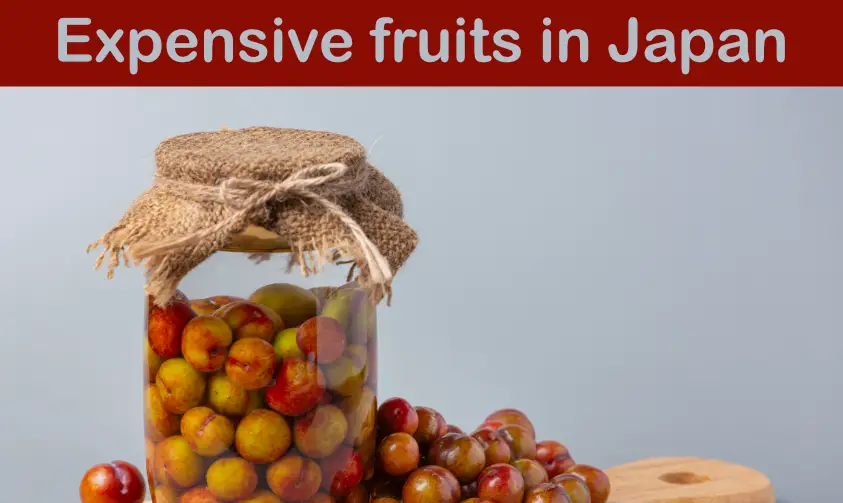Japan is a country of social mysteries; anyhow, for the foreign people, there is one scenario that sounds most strange: the Japanese’ acceptance of, or even admiration and love for, costly fruit. Let’s find out why the Japanese are eager to spend such high to buy fruits.

Premium status
First, fruit in Japan has a much more critical role than in any other country in the world. In the rest of the world, people eat fruit as a snack, but in Japan, people consider it as a valuable gift presented to someone you want to wish luck, show your regards to, or be willing to impress.
Also, it is common to serve a few fruit slices after a high-end kaiseki meal. This splendid status means that the fruit should be worthy of gifting, a premium product.
They should be blemish-free and perfect. In other words, peaches should be rosy and modishly round, strawberries gleaming scarlet, juicy and plump grapes, and melons should be fragrant and totally spherical.
Moreover, fruits correspond to luxury gifts in Japan. A lot of people who want to show their sincere gratitude will mostly offer fruits as presents to their business partners and relatives.
Japanese farmers are also eager to grow premium fruits to get an advantage from their cultural norms.
The fact that the usage of fruits is not limited to snacking makes them some dignified product which has given rise to such a massive price of Japanese fruit.
Labor-intensive farming
Apart from the luxury status, there are various regulations on color, size, and taste. Japan Agricultural Cooperative is a national regulatory body of Japan that sets these regulations when purchasing fruits from farmers for resale.
Mountains occupy about 80 percent of Japan. So, they leave comparatively a tiny area for fruit crops. Small-scale or family-run businesses run a considerable number of fruit farms in Japan.
For them, the cultivation of fruit becomes a labor-intensive process. This process is a sense of pride and tenacity for the Japanese.
For instance, to estimate the lengths to which fruit farmers will go, imagine the muskmelons of Shizuoka. They grow only one melon per vine in climate-controlled greenhouses in uniform rows.
Moreover, they put on small-sized plastic hats to prevent sun damage. Farmers also rub them gently in cotton gloves to stimulate their sweetness.
One more significant factor to keep in mind is that Japan does not have enough land for farming. Only about 12 percent of the land is used to grow crops, primarily for rice production. This is because Japanese firms are smaller in size than those in other countries.
According to statistics, an average size of a farm is only 4.7 acres (1.9 hectares) in comparison to 490 acres (198 hectares) in the United States. Small farms have less efficiency than big ones.
In this way, small farmers have little cash to invest in the machinery required to lessen the costs.
It may be mentioned that Japanese farming is a kind of unsustainable proposition. Like most other things happening there in Japan, demography is to blame.
The average age of a farmer is 65 years or even more. When one farmer dies, no one willingly takes responsibility for the farm. This may cause farming to reach a triple point soon.
In 1961, Japan produced 78% of the food is consumed. By 2006, this percentage dropped to only 39%. Soon, it will fall further. And if it does, shoppers in Japan will begin to pay much less for groceries, ether they like them or not.
Preference for local fruit
Japanese consumers strongly prefer locally produced fruits more over the imported fruits. According to a survey in Japan, about 46 percent of shoppers believe that foreign farm had fruits are less expensive than those of Japanese produced. A high range of 76 percent of shoppers also believes that it is unsafe also.
This disrespect for foreign farm-produced fruits is enough to ensure that a nation of wise urban consumers is shafted in the supermarket regularly.
If seen from another way, the rural way of living at the heart of Japanese traditional culture uplifted by a townsman happy pay over the odds for tomatoes, potatoes, and carrots.
The fruit prices are more likely to increase when foreign fruits with relatively lower prices are not preferred over reasonably high costs of local Japanese fruit.
Seasonal Availability
Seasonal availability is another factor of price fluctuations in Japan as well as in any other region of the world. Some fruits which are popular among the Japanese have seasonal availability.
Primarily, the watermelons and different melon types are commonly associated with summer seasons. On the other hand, apples and strawberries have an association with the winter season.
Since this kind of fruit is not found all year-round, they can fetch very high prices as fruit lovers eagerly snap them up. They just need a chance to purchase them in department stores or supermarkets.
If the same fruits were available year-round, people would not rush to buy them after looking at them. Their rarity has contributed to the increasing demand for these fruits. So, why would it not result in a price increment?
The impact of seasonal availability on fruit prices becomes significantly higher when the state mainly has to rely on local fruits.
If the Japanese had more acceptance of foreign fruit, they could rely on relatively cheap fruit from countries with better production of a particular fruit.
Moreover, it would positively impact trade, which could ultimately result in a high buying capacity of the people.
All thanks to the Japanese culture, which elevates the stature of fruits from a simple eating commodity to some dignified gifts with enormous spiritual and cultural value.
Japanese food culture
Nearly all of the Japanese have a very strong cultural connection to the fruits. They usually eat them for breakfast or as snacks before lunch or dinner.
There are many different kinds of fruit and vegetable snacks in Japan, which are known as “Onigiri” or “Omusubi.”
They may include fruit-shaped cakes made of rice, citrus fruits wrapped in seaweed, and even vegetables wrapped in roasted sticky rice. Onigiri is eaten with a side of Japanese favorite soup, soba noodle, or curry.
To answer the question that why fruits are expensive in Japan, it is necessary to delve into how the Japanese perceive fruit as God’s gift.
Many fruit fans believe that if they prepare food for God by using high-quality fruit, they will be blessed with good health and prosperity.
This kind of thinking does not change when it comes to business with fruits and vegetables.
In addition, many other cultural factors affect the prices of fruits in Japan. And these include the fact that Japanese people have high regard for their elders and seniors.
Children offer their elders to pick from their fruit baskets. The elders are also so generous and kind to share it with younger children and other family members.
Japanese consumers are most willing to pay higher prices for the fruits because they believe that the cost of these fruits is still reasonable when compared to the value that they provide.
Storage and transportation
There is also another important reason why fruits are expensive in Japan. It is because many of them are produced in remote areas where there is no facility for transportation or storage. This means that fruits are taken over long distances without being damaged.
So, fruits are handled with extreme care to get them to the market in the best condition possible. This means that due care is taken during storage and transportation. And since these steps increase the cost of production, the final price of fruits becomes expensive.
Conclusion
All these reasons mentioned above contribute to the sky-high prices of fruit in Japan. Although the Japanese have accepted the high prices up to some extent, the foreigners who visit Japan find it very difficult to come to terms with it.


